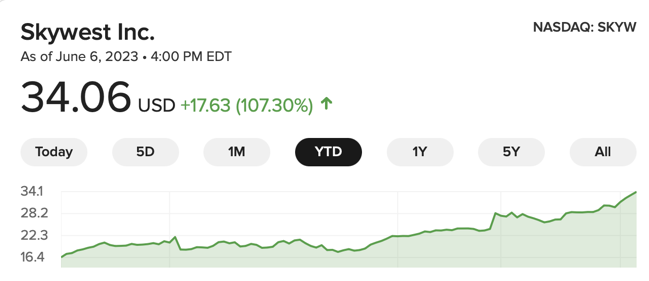Dear Old Friend,
First off, happy birthday to my father today…
I’m sitting in a rundown hotel in Jamaica, New York City – waiting to catch my flight to Baltimore. What a stark difference from 24 hours ago. The air quality in Switzerland is immaculate, fresh, and inviting. In New York, smoke from Canadian wildfires blankets the East Coast. Instead of a red carpet, New York City rolled out an orange sky for me.
Revisiting Our Conversation with Tim, Ben, and Joe.
Two days ago, I introduced you to our friends Ben and Joe. But what I didn’t tell you… the two didn’t join us for drinks at Tim Melvin’s house.
Tim and I discussed the academic writings of value-investing legends Joseph Piotroski and Ben Graham.
We had literature on the table…
There was a copy of Graham’s “The Intelligent Investor” and Piotroski’s “Value Investing: The Use of Historical Financial Statement Information to Separate Winners from Losers” in the Journal of Accounting Research.
You can learn a lot by reading both and witnessing how their insight can work together to find successful investments.
Right now, everyone is talking about Artificial Intelligence – despite their insanely high valuations and concerns about hype.
Instead – we should be focusing on the things that we need.
Tim constantly notes that it’s BORING to buy the stuff we need in this world, right? Energy, food, housing, airlines? Defense?
That’s interesting – because we’re already experiencing one of the worst droughts in decades. DECADES. The U.S. corn crop quality plunged last week in the USDA quality report.
But you don’t see many people talking about it because it’s food. It’s boring.
But Tim always stresses a vital lesson: Boring is better…
Boring can provide us with the best investment strategy in the market. And that’s not me saying this. It’s been confirmed by academics. You know… the people who look at data and can tell us that one number is higher than the other (great work, guys).
How do we do it? Let’s go deeper into my conversation with Tim.
Mister Piotroski Meets Mister Graham
Joseph Piotroski is an accounting professor at Stanford University. Before that, he taught at the University of Chicago.
He created something called the F score.
This nine-point score analyzes the health and strength of a company’s balance sheet.
If the company meets the following criteria, it receives a point for each. A “9” is a perfect score.
- Positive Net Income.
- Positive return on assets in the current year.
- Positive operating cash flow in the current year.
- Cash flow from operations is greater than net Income.
- Lower ratio of long-term debt in the current period compared to the previous year.
- Higher current ratio this year compared to the previous year.
- No new shares were issued in the last year.
- A higher gross margin compared to the previous year.
- A higher asset turnover ratio compared to the previous year.
A company with a 9 out of 9 has an executive board that is extremely shareholder friendly and interested in boosting shareholder value.
Meanwhile, Ben Graham is the godfather of value investing. He’s the man who influenced some of the world’s best long-term investors: Warren Buffett, Charlie Munger… and David Dodd (who worked with Graham at Columbia Business School).
Graham and Dodd identified one anomaly that can’t be arbitraged away - regardless of how many machines trade in this market…
“Value.” That’s a subject that Tim knows a lot about. Value investing is about deriving the “intrinsic value” of a company’s stock independent of the actual company’s price.
So, what does Tim do with his time? He looks at a company’s assets, earnings, and dividend payouts independent of whatever the stock trades for today. So, we use another important metric.
Graham developed something called the Graham number. This figure calculates a stock’s underlying value by analyzing a company’s earnings per share (EPS) and book value per share (BVPS).
By default, it creates an upside number that a shareholder should be willing to pay as a defensive investment. Stocks trading at deep discounts to this number can be a unique value.
But it’s not enough by itself. In 1987, Warren Buffett wrote something that altered my thinking about the markets.
In a letter to shareholders, he said, “We are quite content to hold any security indefinitely, so long as the prospective return on equity capital of the underlying business is satisfactory, management is competent and honest, and the market does not overvalue the business.”
Here we find Piotroski's accounting analysis shows us the importance of competent management and an improving return on equity capital.
And we see the importance of Graham and Dodd’s analysis to help us recognize if the market is over or under-valuing a stock.
Mister Graham, Do Your Dance
In 2016, two academics released a study that said, “fundamental signals derived from financial statements allow for future abnormal stock returns.”
The article was called “Separating winners from losers: Composite indicators based on fundamentals in the European context.” The authors are Borja Amor-Tapia and Maria T. Tascón from the Universidad de León.
What did it uncover? I’ll cut to the chase…
You want to buy stocks with strong F scores, cheap Price-to-Graham numbers, and other healthy metrics or other metrics that offer a turnaround-like potential.
These offers are stocks with a very nice floor and immense upside for a bounce back.
You’d likely be surprised that the stocks on today’s list include housing, energy, mining, and shipping. These companies are incentivizing shareholders to stick around – F scores are strong. Balance sheets are strong. Debt is likely low.
Putting This into Action
In January, I recommended that readers take a stake in SkyWest Inc. (SKYW). The company is a regional operator of domestic airlines – and caters to larger players in the industry. Think puddle jumpers. Now, I warned that the risk for the company centered around the challenges associated with retaining and hiring new pilots.
But at the time, shares were trading at an extremely low Graham number, and it had an F score of 8.

And what happened next?
SkyWest (SKYW) increased by 107.3% year-to-date, which is better than the YTD performances of Alphabet (GOOGL), Apple (AAPL), and Amazon (AMZN) (all three are up roughly 40% to 50% this year). If we can buy a handful of these names – and have just one or two beat the market, we could see a portfolio that guides us well in 2023.
See you out there,
Garrett Baldwin
Florida Republic Capital (Available on Substack)
About the Author
Garrett Baldwin is a globally recognized research economist, financial writer, consultant, and political risk analyst with decades of trading experience and degrees in economics, cybersecurity, and business from Johns Hopkins, Purdue, Indiana University, and Northwestern.



